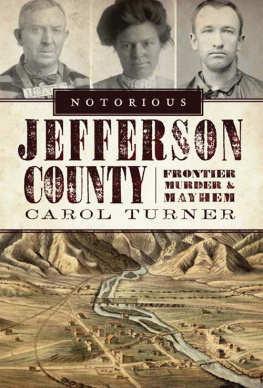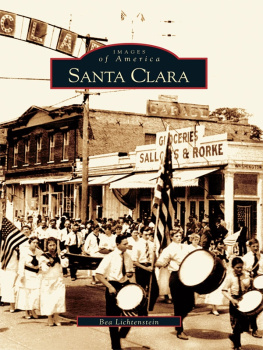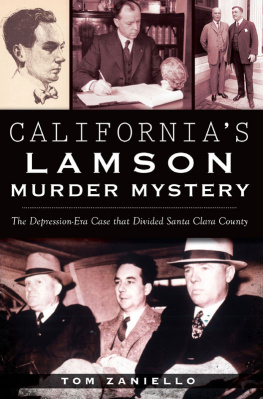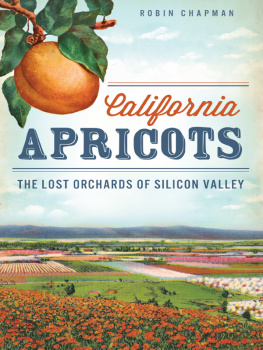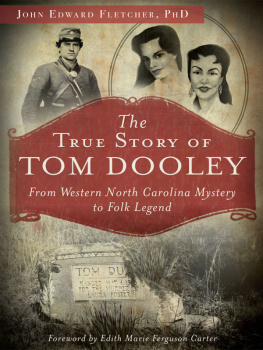


Published by The History Press
Charleston, SC
www.historypress.net
Copyright 2016 by Tom Zaniello
All rights reserved
Front cover, top left : authors collection ; top center : courtesy Special Collections, Stanford University ; top right : courtesy Library of Congress ; bottom : courtesy History San Jose .
First published 2016
e-book edition 2016
ISBN: 978.1.43965.819.2
Library of Congress Control Number: 2016941431
print edition ISBN 978.1.46713.653.2
Notice : The information in this book is true and complete to the best of our knowledge. It is offered without guarantee on the part of the author or The History Press. The author and The History Press disclaim all liability in connection with the use of this book.
All rights reserved. No part of this book may be reproduced or transmitted in any form whatsoever without prior written permission from the publisher except in the case of brief quotations embodied in critical articles and reviews.
The more one investigates criminal trials of the past fifty or one hundred years in America and in England, the harder it is to find one well-established instance of the execution of the death penalty on an innocent person .
Edmund Pearson , Studies in Murder (1937)
Sometimes in cases where the investigators rely on circumstantial evidence the officers jump at conclusions with too much haste. They form an opinion as to the identity of the culprit, and, because they have that opinion and because they are sincere in their belief, they collect only the factual evidence which tends to support their theory. Other facts are discarded because they are not pertinent.
Erle Stanley Gardner , The Court of Last Resort (1957)
CONTENTS
ACKNOWLEDGEMENTS
Yvor Winters and Janet Lewis, David Lamsons friends and advocates, inspired this book. Lewis encouraged my interest in Lamson in an interview arranged by Brigitte Carnochan and introduced me to Lamsons daughter. I learned of Winterss tenacity and intellectual power as a graduate student in his contemporary poetry course at Stanford University. Melissa K. Winters, their granddaughter, kindly provided me with photographs of them for this book.
Robert L. Barth, poet, publisher and friend, was the editor of Winterss correspondence and selected poems and Lewiss poetry and has supported this project in many ways.
A big thank-you for Emily Taylors design of the Lamson home.
Ken Fields and Brigitte Carnochan were generous with excellent advice as I pursued this story.
The University Archives and the Special Collections of the Stanford University Library have provided extraordinary service for my research and photograph needs.
Catherine Mills of History San Jose has been very helpful in securing important illustrations for this book.
At the Santa Clara county clerks office in San Jose, Madeleine Sheinman and Monica Masari facilitated my research into the legal files of the case.
Reporter Jeff Brazil and librarian Pam Allen of the now-defunct Peninsula Times-Tribune (formerly the Palo Alto Times ) were very helpful for my research.
The late Benjamin D. Paul, Stanford University professor, lived at the former home of the Lamsons at 622 Salvatierra Street and was a gracious host for my visits there.
For careful readings of a very early draft that has resulted in numerous improvements, I would like to thank Robert L. Barth and Beverly Storm.
The staff of the Cincinnati Public and the Northern Kentucky University libraries, especially the latters Interlibrary Loan Office, formerly led by Sharon Taylor, have been very supportive of my research.
I am grateful to Northern Kentucky University for a sabbatical and research grant that enabled me to finish a draft of this book.
THE DARK SIDE OF THE VALLEY OF HEART S DELIGHT
Silicon Valley is the latest nickname for the Santa Clara Valley of the San Francisco Peninsula, but in the early twentieth century, it was known as the Valley of Hearts Delight, an Eden of the World, even Paradise. San Jose, its principal city and county seat, was the Garden City.
A legal lynching and a vigilante lynching disturbed the peace in 1933, although this valley of endless orchards of apricots and plums had already been plagued by corrupt goverment, gambling, labor unrest and vigilantes.
The legal lynching, orchestrated by a county political boss, the Santa Clara County sheriff and the district attorney, led to the wrongful conviction of David Lamson for the murder of his wife, Allene Warden Thorpe. The couple had been married on June 18, 1928, on the Stanford campus. Five years later, Allene Lamson was found dead in the couples bathroom; after a scandalous murder trial, her husband was sent to San Quentin for execution.
Soon after Lamson arrived at San Quentin, two foolish kidnappers killed Brooke Hart, the well-known son of a San Jose businessman, and they were lynched in San Jose by a mob led in part by the victims friends and classmates from Santa Clara University.
The lynching was the beginning of the end of the corrupt leadership in Santa Clara County, but fruit cultivation eventually gave way to microchip production, as the tech companies of Silicon Valley replaced the orchards.
The Santa Clara Valley stretches west and south of San Francisco Bay, lying between the Santa Cruz Mountains on the Pacific coast andten to fifteen miles away as the dirigible fliesthe foothills of the Mount Diablo Range to the east. Its neighbor is San Mateo County, lying to the north and west and continuing as the west shore of the bay to the southern border of San Francisco. The line dividing the two counties is the northern boundary of Stanford and Palo Alto, the small city historically tied to the university.

Drawing of David Lamson by an unknown artist, reproduced from The Case of David Lamson: A Summary , published in 1934 by the Lamson Defense Committee. Authors collection .
For years, the only tangible reminder of the Valley of Hearts Delight was a brand of fruit juice: Hearts Delight Apricot Nectar was a product of the Nestle Food Corporation, even when the valley did not supply the apricots. Sunsweet, the first company to can prune juice for commercial sale, also originated in the valley.
Until World War II, the Santa Clara Valley was one of the most fertile growing areas in America, supplying fresh, canned and dried fruits under a seemingly endless sun from April to October and from a seasonal but plentiful supply of water. Janet Lewis, a novelist and poet who lived in Los Altos across the road from 20 acres of apricots and prunes, described this valley, her lifelong home, in Against a Darkening Sky (1943):
In March, roses were in bloom, and the orchards of the Santa Clara Valley had begun the slow procession of fragrance and blossom which was to last another full month, first the almonds, then Imperial prunes, then apricots and French prunes, and peaches, cherries, apples, pearsthe almond trees breaking into green as the apricots turned snowy, apricots in green leaf as the prunes came into blossom, apples and quinces mixing leaf and blossom on the single twig
Next page

